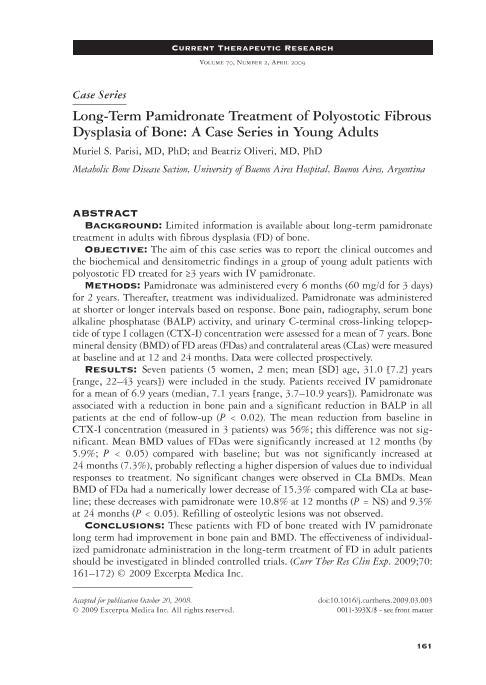Artículo
Long-term pamidronate treatment of polyostotic fibrous dysplasia of bone: A case series in young adults
Fecha de publicación:
04/2009
Editorial:
Elsevier
Revista:
Current Therapeutic Research-clinical And Experimental
ISSN:
0011-393X
Idioma:
Inglés
Tipo de recurso:
Artículo publicado
Clasificación temática:
Resumen
Background: Limited information is available about long-term pamidronate treatment in adults with fibrous dysplasia (FD) of bone. Objective: The aim of this case series was to report the clinical outcomes and the biochemical and densitometric findings in a group of young adult patients with polyostotic FD treated for ≥3 years with IV pamidronate. Methods: Pamidronate was administered every 6 months (60 mg/d for 3 days) for 2 years. Thereafter, treatment was individualized. Pamidronate was administered at shorter or longer intervals based on response. Bone pain, radiography, serum bone alkaline phosphatase (BALP) activity, and urinary C-terminal cross-linking telopep-tide of type I collagen (CTX-I) concentration were assessed for a mean of 7 years. Bone mineral density (BMD) of FD areas (FDas) and contralateral areas (CLas) were measured at baseline and at 12 and 24 months. Data were collected prospectively. Results: Seven patients (5 women, 2 men; mean [SD] age, 31.0 [7.2] years [range, 22-43 years]) were included in the study. Patients received IV pamidronate for a mean of 6.9 years (median, 7.1 years [range, 3.7-10.9 years]). Pamidronate was associated with a reduction in bone pain and a significant reduction in BALP in all patients at the end of follow-up (P < 0.02). The mean reduction from baseline in CTX-I concentration (measured in 3 patients) was 56%; this difference was not significant. Mean BMD values of FDas were significantly increased at 12 months (by 5.9%; P < 0.05) compared with baseline; but was not significantly increased at 24 months (7.3%), probably reflecting a higher dispersion of values due to individual responses to treatment. No significant changes were observed in CLa BMDs. Mean BMD of FDa had a numerically lower decrease of 15.3% compared with CLa at baseline; these decreases with pamidronate were 10.8% at 12 months (P = NS) and 9.3% at 24 months (P < 0.05). Refilling of osteolytic lesions was not observed. Conclusions: These patients with FD of bone treated with IV pamidronate long term had improvement in bone pain and BMD. The effectiveness of individualized pamidronate administration in the long-term treatment of FD in adult patients should be investigated in blinded controlled trials. © 2009 Excerpta Medica Inc. All rights reserved.
Archivos asociados
Licencia
Identificadores
Colecciones
Articulos(INIGEM)
Articulos de INSTITUTO DE INMUNOLOGIA, GENETICA Y METABOLISMO
Articulos de INSTITUTO DE INMUNOLOGIA, GENETICA Y METABOLISMO
Citación
Parisi, Muriel Solange; Oliveri, María Beatriz; Long-term pamidronate treatment of polyostotic fibrous dysplasia of bone: A case series in young adults; Elsevier; Current Therapeutic Research-clinical And Experimental; 70; 2; 4-2009; 161-172
Compartir
Altmétricas




